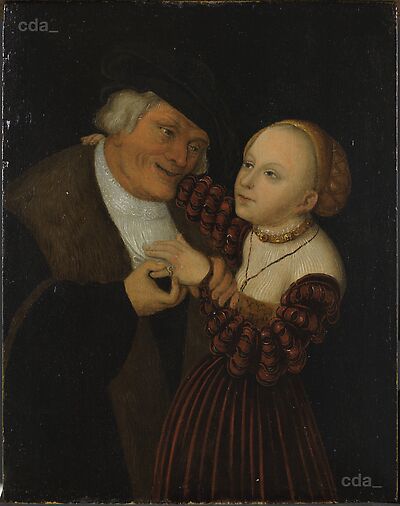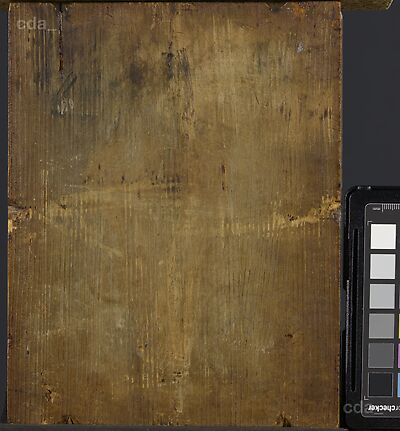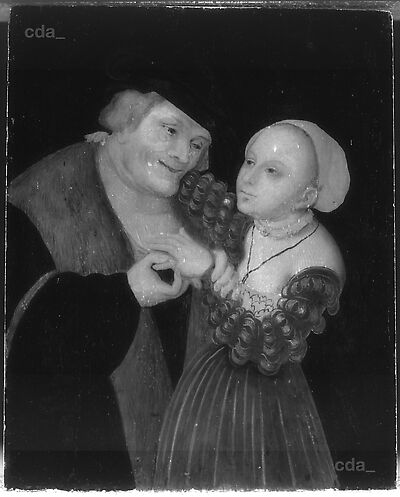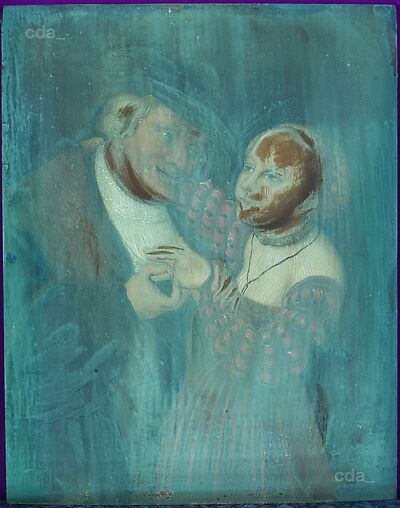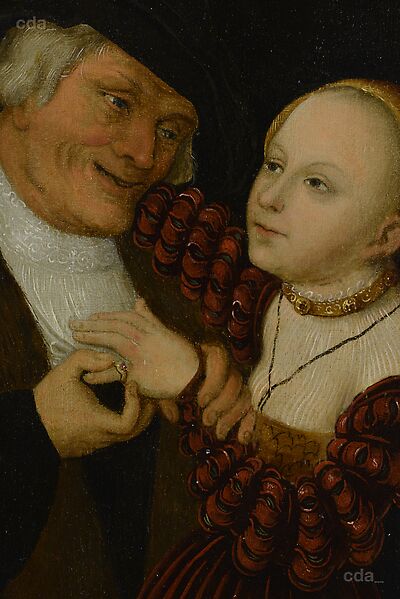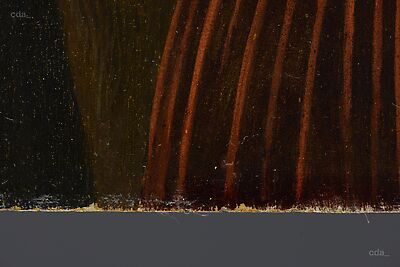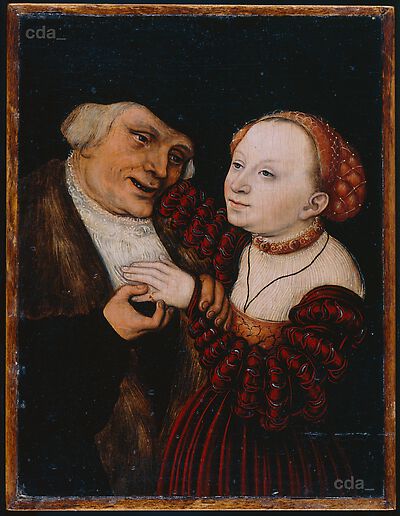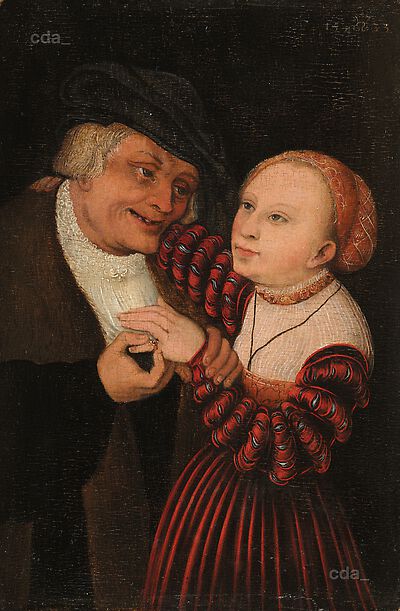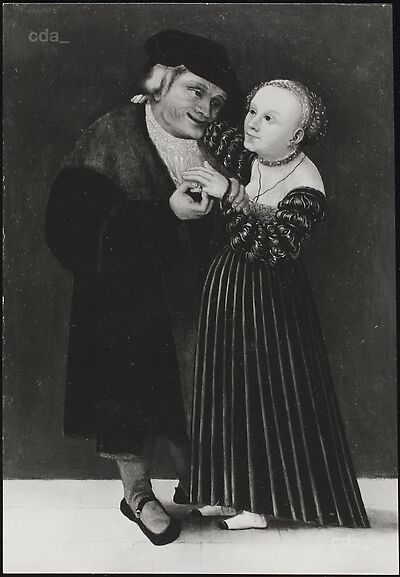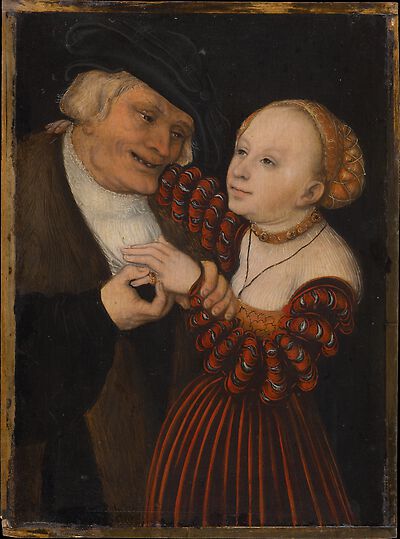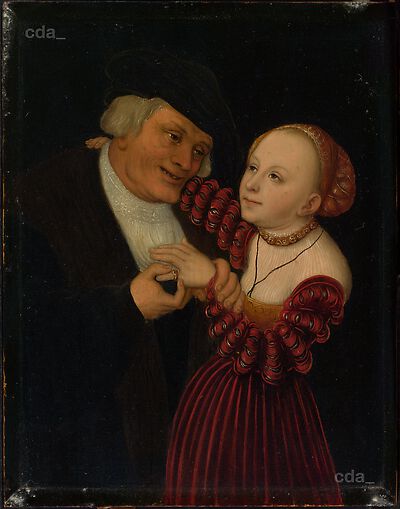Support
The following methods were employed: examination under the stereomicroscope, X RF (Niton XLt), UV-light, x-radiography (Oehm u. Rehbein, Leonardo/ Varex-Perkin Elmer XRPad2 4336) and infrared reflectography (Osiris 900 – 1700 nm)
The results of a technical exammination from September 2021 were also consulted: Prof. Dr. Manfred Schreiner, Untersuchungsbericht. Fotografische Dokumentation und naturwissenschaftliche Untersuchungen an dem Gemälde „Das ungleiche Paar" von Lucas Cranach d. Ä., (1472 – 1553), Öl auf Holz, Wien, September 2021.
Support:
A softwood panel (21.3 x 16.7 x 0.7 cm) with vertical grain orientation. The reverse was smoothed with a claw chisel and also exhibits numerous indentations at regular intervals along the edges. These may be from the original fixtures used to fit the panel in its frame.
Ground and Imprimatura
A thin whitish/pale grey ground extends to the edge of the panel. A barbe is not visible. On all four sides the ground application has partially extended over the edge, suggesting the panel was not framed when the ground was applied, and that its size has not been altered. The streaky application of the ground is visible in the x-radiograph.
Underdrawing
An underdrawing is not readily visible in the infrared reflectogram.
Paint Layers and Gilding
The following elements were detected employing XRF and in combination with their optical properties the following pigments were identified:
Flesh paint: Pb, Ca, Fe (Zn?)
Pb: lead white; Ca: chalk/gypsum (?); Fe: iron oxide/ochre (?)
Yellow hair: Pb, Fe, Ca, Mn, Sn
Pb: lead white; Pb / Sn: lead tin yellow; Fe/ Mn: iron oxide/ochre (?); Ca: chalk/gypsum (?)
Red: Pb, Ca, Hg, Fe (Mn)
Pb: lead white; Ca: chalk/gypsum (?); Hg: vermilion; Fe: iron oxide/ochre (?)
White: Pb, Ca
Pb: lead white; Ca: chalk/gypsum (?)
Yellow/red ring: Pb, Ca, Fe, Sn (Mn)
Pb: lead white; Pb/ Sn: lead tin yellow; Ca: chalk/gypsum (?); Fe/ Mn: iron oxide/ochre (?)
Grey ground: Pb, Ca, Fe, Mn, (Cu)
Pb: lead white; Ca: chalk/gypsum (?); Fe/ Mn: iron oxide/ochre (?); Cu: siccative/ pigment, retouching (?)
Black retouching: Pb, Ca, Cu, Fe
Pb: lead white; Ca: chalk/gypsum (?); Fe/Mn: iron oxide/ochre (?); Cu: siccative, pigment, retouching (?)
The following pigments were identified in the paint layers: lead white, lead tin yellow, vermilion, and iron oxide (red iron oxide and/or brown ochre). In addition small quantities of copper were also detected, possibly as an element in a retouching.
The x-radiograph shows that the paint was applied in thin layers in discrete areas. No major alterations occurred during the painting process: The faces were modulated with a pale red admixture (lead white, red iron oxide) and brownish shadows, while taking advantage of the pale grey ground. The fingers and eyes seem to lack detail. The folds of the woman's red velvet dress were painted in vermilion over a dark red underpaint and then modulated with a red lake glaze. The man's white collar, the fur and the jewellery were added with a fine pointed brush and relatively dry paint.
[Blumenroth, Wu, Heydenreich, unpublished examination report, 22.02.2022]
